Papers by Francisco SALTO ALEMANY

International Journal of Developmental and Educational Psychology. Revista INFAD de Psicología., 2016
RESUMEN El origen de este trabajo arranca del interés por conocer la evolución del razonamiento d... more RESUMEN El origen de este trabajo arranca del interés por conocer la evolución del razonamiento deductivo de la juventud a la vejez. Con el tiempo, los recursos razonadores parecen verse comprometidos y limitados, aunque por otra parte pueden aparecer más flexibles. La literatura sobre razonamiento deductivo considera que éste sucede sólo entre premisas que sean integrables. Del concepto de integración no existe una definición precisa aunque hay cierto acuerdo en considerar que son integrables las premisas cuyos elementos comparten algún término categoremático. En la presente investigación se diseñó, aplicó y analizó un instrumento para medir la deducción en base a aplicar la integración como regla general entre dos premisas para obtener la conclusión. La consistencia interna del instrumento fue de .775 y la validez de contenido fue aprobada por 10 expertos. El diseño transversal contó con una muestra de 37 jóvenes y 42 personas mayores de las que 12 tenían estudios universitarios. El grupo de jóvenes y mayores comenten menos errores en los ítems integrables que en los no integrables (p = .000). Destacablemente, el grupo de jóvenes muestra menor diferencia de aciertos entre inferencias integrables y no integrables. Como conclusión, se explica el amplio número de errores deductivos de mayores en los ítems no integrables porque manejan reglas heurísticas de bajo nivel de abstracción del tipo: si las premisas no son integrables, la inferencia es falsa. El mayor acierto de los jóvenes con inferencias no integrables se explica eventualmente por la búsqueda de razones lógicas subyacentes ante una tarea aparentemente incoherente.

Journal of Philosophical Logic, 2013
Łukasiewicz three-valued logic Ł3 is often understood as the set of all 3-valued valid formulas a... more Łukasiewicz three-valued logic Ł3 is often understood as the set of all 3-valued valid formulas according to Łukasiewicz's 3-valued matrices. Following Wojcicki, in addition, we shall consider two alternative interpretations of Ł3: "welldetermined" Ł3a and "truth-preserving" Ł3b defined by two different consequence relations on the 3-valued matrices. The aim of this paper is to provide (by using Dunn semantics) dual equivalent two-valued under-determined and over-determined interpretations for Ł3, Ł3a and Ł3b. The logic Ł3 is axiomatized as an extension of Routley and Meyer's basic positive logic following Brady's strategy for axiomatizing many-valued logics by employing two-valued under-determined or over-determined interpretations. Finally, it is proved that "well determined" Łukasiewicz logics are paraconsistent. Keywords Many-valued logic • Łukasiewicz 3-valued logic • Two-valued under-determined and over-determined interpretations • Paraconsistent logics
Contextos, 2011
Se presenta, define y aplica una red de conceptos tendente a elucidar la noción de consecuencia l... more Se presenta, define y aplica una red de conceptos tendente a elucidar la noción de consecuencia lógica sobre cuerpos de información no verbalmente codificada. Los problemas y nociones fundacionales de lógicas diagramáticas se discuten críticamente y se generalizan a patrones de ...
Teorema
The range of propositional logics with the Converse Ackermann Property is proved to be wider than... more The range of propositional logics with the Converse Ackermann Property is proved to be wider than currently assumed. Subintuitionistic, positive intuitionistic and intuitionistic propositional logics with the Converse Ackermann Property are defined and axiomatized. A particular version of intuitionistic negation is involved in some of these systems. Complete ternary relational semantics are offered for all logics studied in the paper.
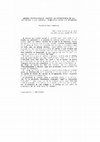
Contextos, 1989
Carelessness and inattention alone can afford us any remedy (7,,2181. No parece ser posible pensa... more Carelessness and inattention alone can afford us any remedy (7,,2181. No parece ser posible pensar ni percibir algo como parte de sl mismo. Lo percibido y lo pensado no parecen poder aparecer sino siendo f'algorf (sf mismo) distinto de lo que le es diferente. Puedo distinguir, o imaginar que distingo, cuantas unidades distintas desee en un grano de arena. Pero siempre ocurrirá que lo distinguido será en cada caso un granito distinto. Puedo dividir mentalmente un conjunto en una cantidad cualquiera de partes. Y por dividida que .esté cada parte, cada división mostrará una unidad distinta. No parece pensable ni imaginable lo que carezca de ser ttlo quet' sea, esto es, carezca de la unidad del 'talgof' De todo lo que sea perceptible o pensable parece que, al menos, debe de poder decirse que sea rralgorr diferente (que sea sí mismo). Predicados como rrser algott, ttser unott o ffser sí mismoil no sirven para distinguir ni contrastar algunas cosas de otras cosas. Por el
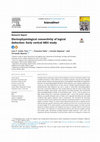
Cortex, 2023
Complex human reasoning involves minimal abilities to extract conclusions implied in the availabl... more Complex human reasoning involves minimal abilities to extract conclusions implied in the available information. These abilities are considered “deductive” because they exemplify certain abstract relations among propositions or probabilities called deductive arguments. However, the electrophysiological dynamics which supports such complex cognitive processes has not been addressed yet. In this work we consider typically deductive logico-probabilistically valid inferences and aim to verify or refute their electrophysiological functional connectivity differences from invalid inferences with the same content (same relational variables, same stimuli, same relevant and salient features). We recorded the brain electrophysiological activity of 20 participants (age = 20.35 ± 3.23) by means of an MEG system during two consecutive reasoning tasks: a search task (invalid condition) without any specific deductive rules to follow, and a logically valid deductive task (valid condition) with explicit deductive rules as instructions. We calculated the functional connectivity (FC) for each condition and conducted a seed-based analysis in a set of cortical regions of interest. Finally, we used a cluster-based permutation test to compare the differences between logically valid and invalid conditions in terms of FC. As a first novel result we found higher FC for valid condition in beta band between regions of interest and left prefrontal, temporal, parietal, and cingulate structures. FC analysis allows a second novel result which is the definition of a propositional network with operculo-cingular, parietal and medial nodes, specifically including disputed medial deductive “core” areas. The experiment discloses measurable cortical processes which do not depend on content but on truth-functional propositional operators. These experimental novelties may contribute to understand the cortical bases of deductive processes.

Brain Informatics, 2023
Introduction Logically valid deductive arguments are clear examples of abstract recursive computa... more Introduction Logically valid deductive arguments are clear examples of abstract recursive computational procedures on propositions or on probabilities. However, it is not known if the cortical time-consuming inferential processes in which logical arguments are eventually realized in the brain are in fact physically different from other kinds of inferential processes. Methods In order to determine whether an electrical EEG discernible pattern of logical deduction exists or not, a new experimental paradigm is proposed contrasting logically valid and invalid inferences with exactly the same content (same premises and same relational variables) and distinct logical complexity (propositional truth-functional operators). Electroencephalographic signals from 19 subjects (24.2 ± 3.3 years) were acquired in a two-condition paradigm (100 trials for each condition). After the initial general analysis, a trial-by-trial approach in beta-2 band allowed to uncover not only evoked but also phase asynchronous activity between trials. Results showed that (i) deductive inferences with the same content evoked the same response pattern in logically valid and invalid conditions, (ii) mean response time in logically valid inferences is 61.54% higher, (iii) logically valid inferences are subjected to an early (400 ms) and a late reprocessing (600 ms) verified by two distinct beta-2 activations (p-value < 0,01, Wilcoxon signed rank test). Conclusion We found evidence of a subtle but measurable electrical trait of logical validity. Results put forward the hypothesis that some logically valid deductions are recursive or computational cortical events.
Reports on Mathematical Logic, 2005
Minimal Negation is defined within the basic positive relevance logic in the relational ternary s... more Minimal Negation is defined within the basic positive relevance logic in the relational ternary semantics: B+. Thus, by defining a number of subminimal negations in the B+ context, principles of weak negation are shown to be isolable. Complete ternary semantics are offered for minimal negation in B+. Certain forms of reductio are conjectured to be undefinable (in ternary frames) without extending the positive logic. Complete semantics for such kinds of reductio in a properly extended positive logic are offered.
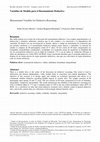
Revista Iberoamericana de Diagnóstico y Evaluación – e Avaliação Psicológica, 2018
Hay doble pulsión en el centro de la discusión del razonamiento deductivo. Una conduce aparenteme... more Hay doble pulsión en el centro de la discusión del razonamiento deductivo. Una conduce aparentemente a la abstracción y dominios arbitrarios, mientras que la otra conduce a la concreción y la dependencia del contenido. El objetivo de esta investigación es diseñar, aplicar y validar un instrumento de evaluación que nos permita corroborar si el razonamiento deductivo maneja reglas lógicas o contenidos. La muestra de estudio se compuso de 80 participantes (edad 18-77 años). El test consta de 60 ítems categorizados en: formalidad, integrabilidad, complejidad y modalidad. Los resultados ponen de manifiesto la fiabilidad del test de razonamiento deductivo con un alpha de Cronbach .775 y con un índice de validación .850 para el índice de inteligencia no verbal (INV) del RIAS. Cómo conclusión inferimos que el razonador deductivo no dispone de un cuerpo preciso de reglas generales deductivas, sino que usa colecciones de reglas heurísticas cada vez menos abstractas.
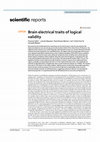
Scientific Reports, 2021
Neuroscience has studied deductive reasoning over the last 20 years under the assumption that ded... more Neuroscience has studied deductive reasoning over the last 20 years under the assumption that deductive inferences are not only de jure but also de facto distinct from other forms of inference. The objective of this research is to verify if logically valid deductions leave any cerebral electrical trait that is distinct from the trait left by non‐valid deductions. 23 subjects with an average age of 20.35 years were registered with MEG and placed into a two conditions paradigm (100 trials for each condition) which each presented the exact same relational complexity (same variables and content) but had distinct logical complexity. Both conditions show the same electromagnetic components (P3, N4)
in the early temporal window (250–525 ms) and P6 in the late temporal window (500–775 ms). The significant activity in both valid and invalid conditions is found in sensors from medial prefrontal regions, probably corresponding to the ACC or to the medial prefrontal cortex. The amplitude and intensity of valid deductions is significantly lower in both temporal windows (p = 0.0003). The reaction time was 54.37% slower in the valid condition. Validity leaves a minimal but measurable hypoactive electrical trait in brain processing. The minor electrical demand is attributable to the recursive
and automatable character of valid deductions, suggesting a physical indicator of computational deductive properties. It is hypothesized that all valid deductions are recursive and hypoactive.
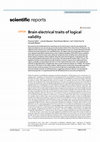
Scientific Reports, 2021
Neuroscience has studied deductive reasoning over the last 20 years under the assumption that ded... more Neuroscience has studied deductive reasoning over the last 20 years under the assumption that deductive inferences are not only de jure but also de facto distinct from other forms of inference. The objective of this research is to verify if logically valid deductions leave any cerebral electrical trait that is distinct from the trait left by non‐valid deductions. 23 subjects with an average age of 20.35 years were registered with MEG and placed into a two conditions paradigm (100 trials for each condition) which each presented the exact same relational complexity (same variables and content) but had distinct logical complexity. Both conditions show the same electromagnetic components (P3, N4) in the early temporal window (250–525 ms) and P6 in the late temporal window (500–775 ms). The significant activity in both valid and invalid conditions is found in sensors from medial prefrontal regions, probably corresponding to the ACC or to the medial prefrontal cortex. The amplitude and intensity of valid deductions is significantly lower in both temporal windows (p = 0.0003). The reaction time was 54.37% slower in the valid condition. Validity leaves a minimal but measurable hypoactive electrical trait in brain processing. The minor electrical demand is attributable to the recursiveand automatable character of valid deductions, suggesting a physical indicator of computational deductive properties. It is hypothesized that all valid deductions are recursive and hypoactive.

Revista de Neurología, 2019
Semantic content processing is associated with the potential N400, and the P600 is linked with th... more Semantic content processing is associated with the potential N400, and the P600 is linked with the processing of syntactic and grammatical rules. To verify whether the semantic processing of complex visual stimuli such as repetition, identity, order and double incongruence is recursive or computable. 27 university students responded to an adapted N400 paradigm with five conditions, each with 80 tasks, while recording their brain activity with a 64-channel cap. Two temporal windows of 400 to 550 ms and 550 to 800 ms were analyzed using an ANOVA contrast of the condition factor by regions of interest. In addition, the inverse solution of the windows was calculated by low resolution electromagnetic tomography (LORETA) to identify the main sources related to the electrical power. The significant differences (p <0.05) in the results for the N400 and P600 in frontal and centroparietal areas in the logical operators studied are corroborated. It is confirmed that the brain processing of complex images is modulated by repetition, identity and order, but not by negation. Therefore, it can be said that the semantic processing of complex images is semi-computable.
El uso de los ordenadores se ha convertido en algo habitual en el mundo moderno, pero todavía se ... more El uso de los ordenadores se ha convertido en algo habitual en el mundo moderno, pero todavía se sabe poco acerca de cómo se relaciona con el rendimiento mental de las personas mayores usuarias de nuevas tecnologías. Aunque la investigación muestra que capacidades cognitivas altas predicen el éxito en el ordenador [1], los datos hoy en día son controvertidos. Se desconoce la naturaleza de esta asociación: no está claro si personas brillantes optan por utilizar el ordenador, o el uso del ordenador puede ayudar a mantener las capacidades cognitivas. Las consecuencias de este problema son importantes dado que el uso habitual de esta herramienta podría proteger a las personas mayores no solo del riesgo a ser marginados en la sociedad moderna, sino que además conseguiría ayudar a mantener la agudeza mental a medida que se envejece.

Revista Iberoamericana de Diagnóstico y Evaluación – e Avaliação Psicológica, Oct 1, 2018
Las teorías cognitivo-emocionales del envejecimiento afirman que con la edad aumenta el sesgo emo... more Las teorías cognitivo-emocionales del envejecimiento afirman que con la edad aumenta el sesgo emocional con valencia positiva en el procesamiento de la información que realizan las personas mayores. En este artículo se aborda el concepto de positividad en el envejecimiento y se discute en relación al déficit del control inhibitorio y la percepción del tiempo limitado, características asociadas a la edad. ASBTRACT The cognitive-emotional theories of aging affirm that with age increases the emotional bias with positive valence in the processing of information that elderly people perform. In this article the concept of positivity in aging is discussed in relation to the deficit of inhibitory control and the perception of limited time, characteristics associated with age. INTRODUCCIÓN Positividad en el envejecimiento El efecto potenciador de la memoria de personas mayores se denomina "efecto de positividad". El envejecimiento se caracteriza por mayor rendimiento cognitivo en tareas que tienen contenido emocional vs. no emocional y dicho rendimiento es más evidente ante contenido emocional positivo que negativo (Immordino-Yang, Yang, & Damasio, 2016). Sin embargo, algunos estudios no encuentran evidencia contundente de estos resultados (Hess, Landmann, David, & Hareli, 2017). Según Kensinge y Gutchess (2017) las diferencias del funcionamiento cognitivo, en función del contenido emocional en la vejez, se deben a que determinadas áreas neuronales de la cognición se atro
The notion of critical theory has a general and a specific meaning (Maces 2001: 74f, Payne 1997: ... more The notion of critical theory has a general and a specific meaning (Maces 2001: 74f, Payne 1997: 118). Critical theory as a general term means theories that are critical of capitalism and domination. Critical Theory as a more specific term means the work of the Frankfurt School, and particularly of Theodor W. Adorno, Max Horkheimer, Jürgen Habermas, and Herbert Marcuse. Its starting point is the work of Karl Marx (Held 1980: 15, Macey 2001: 75, Payne 1997: 118, Rush 2004: 9, Wiggershaus 1994: 5). For Horkheimer and his colleagues, critical theory “was a camouflage label for ‘Marxist theory’” (Wiggershaus 1994: 5) when they were in exile from the Nazis in the USA, where they were concerned about being exposed as communist thinkers and therefore took care in the categories they employed.
tripleC: Communication, Capitalism & Critique. Open Access Journal for a Global Sustainable Information Society
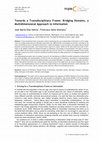
Proceedings of The 4th International Conference on the Foundations of Information Science
A trans-disciplinary frame is proposed, aimed at addressing the very understanding of information... more A trans-disciplinary frame is proposed, aimed at addressing the very understanding of information in all its variety. It aims at unifying perspectives and integrating techniques from different fields of knowledge and practice, searching for the most overarching account of information phenomena, a better formalization of real processes and a global stance towards problems concerning information. Such research frame might try to answer: Which are the basic distinct accounts of information to be applied in fields from telecommunication to philosophy, from biology to documentation, from logic to quantum physics? Which are the minimum primitive concepts that may cover all of them? Is a unified theory feasible? Could a better information measure be found? Could the societal and practical interest be better preserved in an integrated perspective of information? The methodological proposal aims at opening a space for the interweaving of different scientific frameworks (characterized by specific paradigms and methodologies) to delve into the very landscape of information, searching for a transdisciplinary treatment of theoretical, technical and practical problems concerning information. It is based on an already active interdisciplinary International community and a critical mass of research groups at the global level. By means of bridging these communities, a new transdisciplinary science of information might emerge as an integrated framework in which information will be considered in all its formal, natural, cognitive, social, technical, ethical and philosophical aspects.
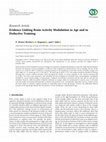
Neural Plasticity
Electrical brain activity modulation in terms of changes in its intensity and spatial distributio... more Electrical brain activity modulation in terms of changes in its intensity and spatial distribution is a function of age and task demand. However, the dynamics of brain modulation is unknown when it depends on external factors such as training. The aim of this research is to verify the effect of deductive reasoning training on the modulation in the brain activity of healthy younger and older adults (N=47 (mean age of 21 ± 3.39) and N=38 (mean age of 68.92 ± 5.72)). The analysis reveals the benefits of training, showing that it lowers cerebral activation while increasing the number of correct responses in the trained reasoning task (p<0.001). The brain source generators were identified by time-averaging low-resolution brain electromagnetic tomography (sLORETA) current density images. In both groups, a bilateral overactivation associated with the task and not with age was identified. However, while the profile of bilateral activation in younger adults was symmetrical in anterior are...

Uploads
Papers by Francisco SALTO ALEMANY
in the early temporal window (250–525 ms) and P6 in the late temporal window (500–775 ms). The significant activity in both valid and invalid conditions is found in sensors from medial prefrontal regions, probably corresponding to the ACC or to the medial prefrontal cortex. The amplitude and intensity of valid deductions is significantly lower in both temporal windows (p = 0.0003). The reaction time was 54.37% slower in the valid condition. Validity leaves a minimal but measurable hypoactive electrical trait in brain processing. The minor electrical demand is attributable to the recursive
and automatable character of valid deductions, suggesting a physical indicator of computational deductive properties. It is hypothesized that all valid deductions are recursive and hypoactive.
in the early temporal window (250–525 ms) and P6 in the late temporal window (500–775 ms). The significant activity in both valid and invalid conditions is found in sensors from medial prefrontal regions, probably corresponding to the ACC or to the medial prefrontal cortex. The amplitude and intensity of valid deductions is significantly lower in both temporal windows (p = 0.0003). The reaction time was 54.37% slower in the valid condition. Validity leaves a minimal but measurable hypoactive electrical trait in brain processing. The minor electrical demand is attributable to the recursive
and automatable character of valid deductions, suggesting a physical indicator of computational deductive properties. It is hypothesized that all valid deductions are recursive and hypoactive.